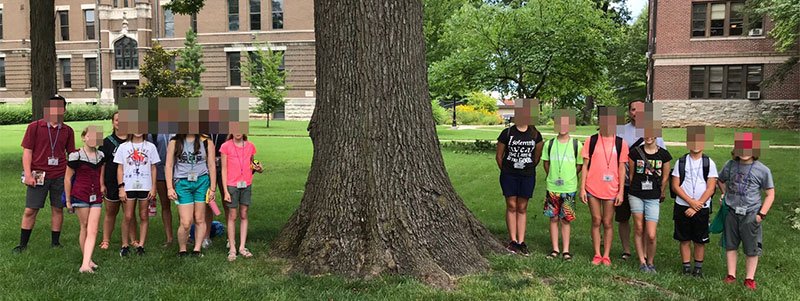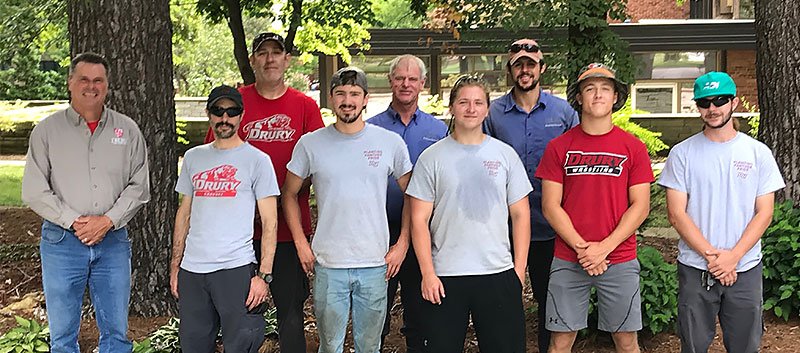Wow, You’ve Done A Lot Here...
Groundskeeping is a challenging profession. We are impacted and affected by horticultural limitations, weather and environment, organizational imperatives, laws and regulations, budgetary constraints, seasonal influences, etc. We are in a constant battle of managing inputs, stressors and outcomes. In all of this grind, we must occasionally factor in a crisis of the now, where we focus on where our operation currently is and what lay immediately before us.
Recently I had an opportunity to step out of my job as Head Groundskeeper/Manager and step into a role as instructor. I was contacted by Dr. Kris Wiley (former Drury professor) to speak about the campus landscape to a group of gifted middle schoolers in a program called SummerScape. I wanted to articulate to these students that my job, the role of the grounds crew, and our work, was incredibly complex, rich with fulfillment and purpose, and touched every person who came on campus. I didn’t have an outline and being prone to train of thought/tangential thinking, I just jumped, in letting the tour take its own direction. What follows below is simply a stream-of-consciousness recounting of the topics we touched on. They are in no order but based on recall several weeks after the fact. If anyone thinks grounds departments don’t do it all, read this list.

Head Groundskeeper. Grounds Crew. Make the campus beautiful for our community. Education. Support the organizational goals. Ecology. Environmentalism. Outreach. Cost effective. Sky to subsoil. Air. Water. Land. Trees. Shrubs. Flowers. Grass. Drury Fusion program. Jordan Valley Park. Palace at Versailles. Florence, Italy. Central park. Lurie Garden. Biltmore estate. My backyard. Community. TreeCampusUSA. Garden visitor. Landscape design. Landscape Architecture. National Arboretum. Morton Arboretum. St. Louis Botanic Gardens. Strategic Plan. Weekly schedule. Have fun. Lots of different personalities. Teamwork. Friends. Thanks. Criticism.
Climate change. Genetically modified organisms. Photosynthesis. Senescence. Organic matter. How fallen twigs as mulch may replicate a natural process. Red-tail hawks. Keystone species. Cambium. Ecology. Natural gas and alternative powered equipment. Missouri Department of Conservation restoration project and grant. N-P-K. 16 elements required for plant growth. "C Hopkins café managed by mine cuzn mo cl" (a mnemonic device using the elemental symbols to help memorize the 17 essential plant nutrients). Most nutrients for plant growth supplied by air and water. Irrigation. Water conservation. Honey bees. Honeybee decline. Decomposition. The Great Plains. Land disturbance. Grazing. Fire. Mt. Saint Helens. Succession. Pollinators. Tree growth. Pollution, Reduce, reuse, recycle. Social media. Ants. Electron transport chain. Hydrogen ions. Cation exchange. Potential of Hydrogen. Cars. Monarch migration. Rabbits. Hollow trees. Tree retrenchment. Adventitious growth. Working with a fraternity service project to plant 20 Missouri native shrubs.
Rain gardens. Soil structure. Infiltration rate. Use a coffee can hammered halfway into the ground, fill with water and time how long for it to soak in. Commemorative trees. Urban forest. International Society of Arborists (ISA). Certified arborist. N-P-K. Board Certified Master Arborist. Retired MU turf expert Dr. Brad Fresenburg. Professional Grounds Management Society (PGMS). Certified Grounds Manager (CGM). Sports Turf Managers Association (STMA). Golf Course Superintendent Association of America (GCSAA). Restoration gardens. Heirloom seed. Planned sterility to prevent seed formation. Plant patents. Organic fertilizer. Decreasing chemical use. FRAC codes. Corn gluten. Pelletized alfalfa. Fertilizer analysis.

Botanist. American beaver. American Indians. The Great Spirit. What happens to soil that has been under a building for more than 100 years. Fallen logs. Placing logs to create insect habitat. Insect hotels. Architecture. Student volunteers. Entomology. Hydrology. Irrigation association. Smart Irrigation. Smart irrigation month. Certified irrigation auditor. Precipitation rate. Rain sensor. Adjusting irrigation programming. Evapo-transpiration (ET). Certified pesticide applicator. Missouri Department of Agriculture. Pesticide inspectors. Round up. Glyphosate. Acetic acid. Citric acid. Smell of Oranges. Organic materials Review Institute (OMRI). USDA certified organic program. National Audubon society. Eastern Bluebirds. Skunks. Snakes. Nothing cuter than a baby skunk.
After several sessions with these kids, in an informal and unstructured setting, and without a script, what resulted was essentially a recounting of the work that has taken place at Drury since 2012 (much homage has to go to my groundskeeper predecessors because none of us usually walk into a blank slate landscape). Behind each topic is a story which represents the heart, mind, and muscle of the Grounds Crew that allowed it to come to be.
What I found most fulfilling was a comment from one of the students at the end of a tour: “Wow, you’ve done a lot here”. Yes, we have.

The 2019 DU Summer Grounds Crew proudly upheld the standards of Grounds Crews everywhere.
L-R Joe, Andre, Dave, Andrew (DU Student), Leroy, Matt (DUS), Conner, Riley (DUS), Cole


0 Comments
Recommended Comments
There are no comments to display.